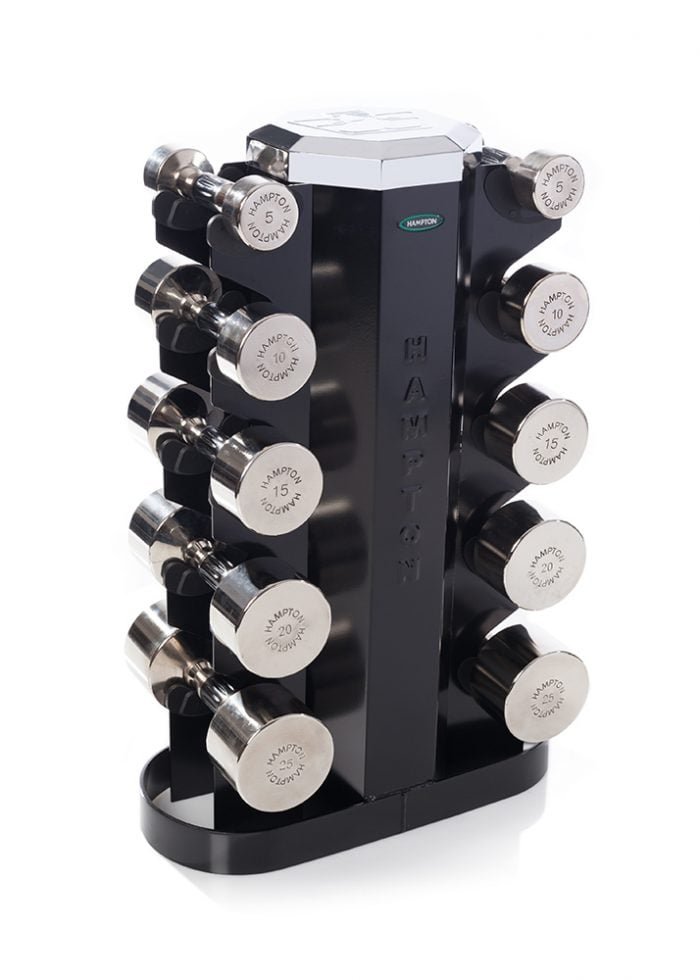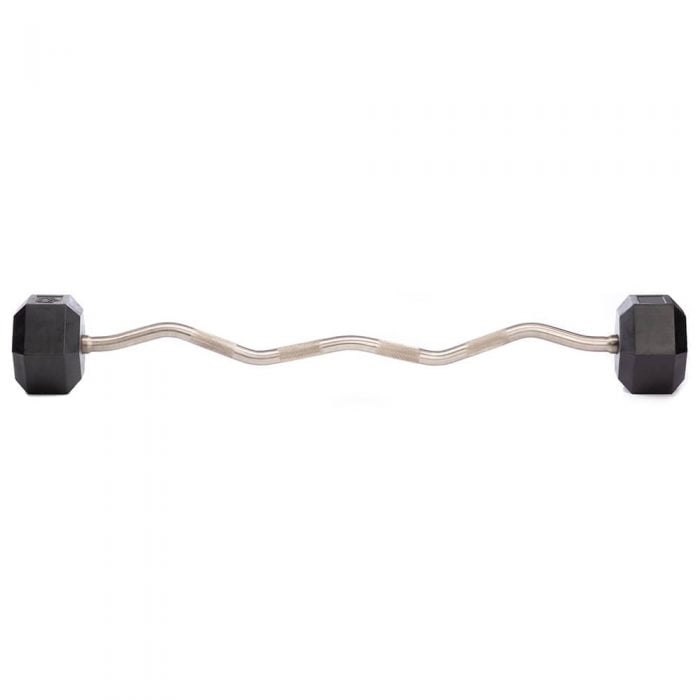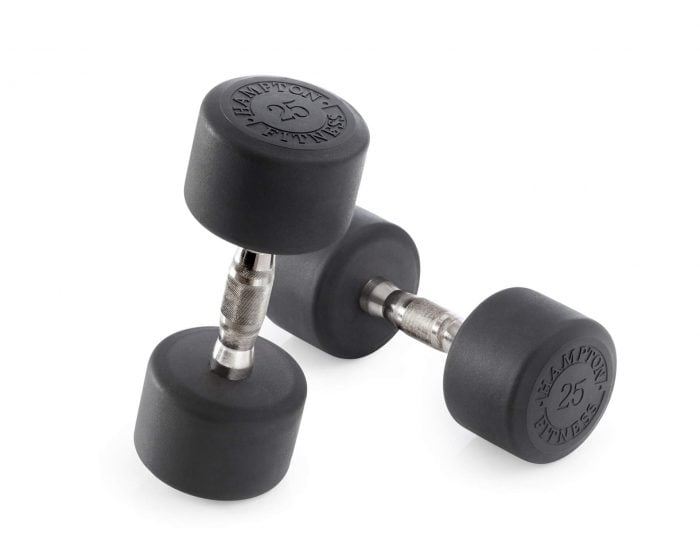It’s important to regularly work on each muscle group in your overall training plan. However, understanding the mechanics related to “why” you’re training each group is also essential. Training your biceps and triceps together creates a powerful arm workout that promotes increased strength and improved aesthetics and is incredibly helpful in conducting everyday activities.
Key takeaways:
- Training the biceps and triceps is important for building and maintaining everyday strength.
- You can train biceps and triceps 2-6 times a week, though 2-3 times per week will be sufficient for most.
- Always train your biceps and triceps in a way that’s relative to your goal.
- Make sure to use proper form while completing your arm workout to avoid injury.
Bicep Exercises
Standing Barbell Biceps Curl
This common arm exercise mostly targets the biceps. A standing barbell curl involves holding a barbell with an underhand grip and curling the weight toward your chest while keeping elbows locked in position. This type of curl is often used in bodybuilding regimens. It’s considered a compound movement that targets the biceps while simultaneously engaging forearms, shoulders, and upper back muscles. Strengthening these muscles can improve upper body strength, muscle mass, and athletic performance.
To perform a standing barbell curl, follow these steps:
- Begin by standing with your feet shoulder-width apart, with your knees slightly bent and your core engaged.
- Grasp the barbell with an underhand grip, with your hands slightly wider than shoulder-width apart.
- Hold the barbell with your arms fully extended down in front of your body, with your palms facing upwards.
- Keeping your elbows stationary, curl the barbell upwards towards your chest by contracting your biceps.
- Hold the contraction for a second or two, then lower the barbell back to the starting position.
- Repeat the exercise for the desired number of repetitions.
Hammer Curl
Hammer curls target the upper arms’ biceps muscles, forearms, and brachialis muscles. The exercise involves holding a pair of dumbbells with a neutral grip (palms of the hands facing each other). This exercise is a great way to improve grip strength. The hammer curl is a great way to prevent injury and increase muscle stimulation aside from doing bicep curls. Hammer curls can be varied using different weights and higher or lower weights to achieve greater muscle mass, improve strength, and up endurance.
To perform a hammer curl, follow these steps:
- Stand with your feet shoulder-width apart, holding a pair of dumbbells in your hands with your palms facing each other.
- Keep your elbows close to your body and your upper arms stationary.
- Slowly curl the dumbbells towards your shoulders, maintaining a neutral grip throughout the movement.
- Hold the contraction for a second or two, then slowly lower the dumbbells back to the starting position.
- Repeat the exercise for the desired number of repetitions.
Seated Alternating Dumbbell Curl
The seated alternating dumbbell curl is a weightlifting exercise that targets the biceps muscles of the upper arms, as well as the forearms and brachialis muscles. To complete this exercise, you’ll be holding a pair of dumbbells and curling them alternately, one arm at a time, while seated on a bench or chair.
To perform a seated alternating dumbbell curl, follow these steps:
- Sit on a bench or chair with your feet flat on the floor and your back straight.
- Hold a pair of dumbbells in your hands, with your palms facing forward.
- Keep your elbows close to your body and your upper arms stationary.
- Slowly curl one dumbbell towards your shoulder, keeping your wrist straight and your palm facing your body.
- Hold the contraction for a second or two, then lower the dumbbell back to the starting position.
- Repeat the exercise with the opposite arm.
- Continue alternating arms until you have completed the desired number of repetitions.
The seated alternating dumbbell curl is often used in upper body workouts to target the biceps and forearms and can effectively improve strength and muscle definition. This exercise is often performed on a bench or chair to reduce other muscles’ involvement and increase the biceps’ isolation. The seated alternating dumbbell curl can be performed using different weights and repetitions to achieve different fitness goals, such as building muscle mass; improving strength or endurance.
Concentration Curl
A concentration curl is a weightlifting exercise that targets the upper arms’ biceps muscles and the brachialis muscle. The exercise involves curling a single dumbbell with one arm while stabilizing the elbow inside the same-side thigh. The concentration curl is often used in upper body workouts to target the biceps and brachialis muscles, effectively isolating the biceps and increasing muscle definition. This exercise is performed with lighter weights compared to other bicep exercises, which allows for a greater emphasis on proper form and technique. The concentration curl can be performed using different weights and repetitions to achieve different fitness goals, such as building muscle mass and improving strength or endurance.
To perform a concentration curl, follow these steps:
- Sit on a bench or chair with your feet flat on the floor, and hold a dumbbell in one hand.
- Rest the back of your upper arm against the inside of your same-side thigh.
- Keep your elbow close to your body and your upper arm stationary.
- Slowly curl the dumbbell towards your shoulder, keeping your wrist straight and your palm facing your body.
- Hold the contraction for a second or two, then slowly lower the dumbbell back to the starting position.
- Repeat the exercise for the desired number of repetitions, then switch to the opposite arm.
Recommended products
-
CHROME BEAUTY-GRIP | FIVE PAIR Pack
$1,435.00 -
Urethane DURA-PRO Dumbbells | 55-100 LB SET
$6,816.00
Tricep Exercises
Close-Grip Bench Press
The close grip bench press is a strength training exercise that targets the triceps muscles, chest, and shoulders. It is similar to the regular bench press, but the grip used in this exercise is narrower than the standard bench press, with hands placed roughly 8 to 12 inches apart on the barbell. While performing this exercise, keep your elbows close to your body to engage your triceps and reduce unnecessary shoulder strain and the chance of injury. Varying the elevation of the bench will help you target different muscle groups as you train. Performing the exercise on an incline bench will target the upper portion of the chest while performing it on a decline bench will target the lower portion of the chest.
To perform a close grip bench press, follow these steps:
- Lie on a flat bench with your feet flat on the floor and your eyes directly under the bar.
- Place your hands on the bar with a slightly narrower grip than shoulder-width apart. Your palms should be facing toward your feet.
- Unrack the bar and bring it down towards your chest. Keep your elbows close to your body throughout the movement.
- Pause briefly when the bar is just above your chest, then press the bar back up towards the starting position, keeping your arms straight and your elbows close to your body.
- Repeat the movement for the desired number of repetitions.
Overhead Triceps Dips
Much like traditional bench-based tricep dips, overhead dips target the tricep muscles. It’s important to keep your back straight and your elbows close to your body throughout the exercise to ensure proper form and avoid injury. Always choose an appropriate weight for your fitness level.
To perform overhead tricep dips, follow these steps:
- Sit on a bench or a stable surface with your feet flat on the ground and your knees bent at a 90-degree angle. Place a dumbbell on your lap.
- Grip the dumbbell with both hands, holding it overhead with your arms fully extended.
- Lower your body by bending your elbows, keeping your elbows close to your body and your back straight. Lower your body until your arms are at a 90-degree angle or slightly lower.
- Push back up by straightening your arms until you return to the starting position.
- Repeat for the desired number of reps.
Skull Crushers
Skull crushers, also known as lying tricep extensions, are a popular strength training exercise that targets the tricep muscles. The exercise is performed lying on a flat bench, with the weight or resistance held above the head and the arms extended towards the ceiling. It is important to maintain proper form throughout the exercise to avoid injury. As you work through a set of skull crushers, don’t forget to keep your elbows close to your body and avoid flaring them out to the sides. This will help isolate the triceps and prevent injury to the shoulders. It’s essential to use a weight or resistance appropriate for your strength level and avoid overexerting yourself. A weight that’s bigger than necessary will cause unnecessary strain that could lead to injury.
To perform skull crushers, follow these steps:
- Lie flat on a bench with your feet flat on the floor and your head under the bar or weight. Hold the bar or weight with both hands, with your palms facing up and your hands about shoulder-width apart.
- Extend your arms towards the ceiling, keeping your elbows in and your upper arms stationary. This is the starting position.
- Slowly lower the weight towards your forehead, bending your elbows and keeping your upper arms stationary.
- Pause momentarily when the weight is just above your forehead, then press the weight back up towards the ceiling, extending your arms and keeping your elbows in.
- Repeat the movement for the desired number of repetitions.
Triceps Kickbacks
Tricep kickbacks are a strength training exercise that targets the tricep muscles located at the back of the upper arms. They are typically performed using dumbbells or other weights but can also be done using resistance bands. The exercise involves extending the arms behind the body, using the triceps to control the movement. As you do this exercise, keep your back flat and avoid hunching. Focus on squeezing your triceps at the movement’s top to benefit most from the exercise. Use a weight that is appropriate for your strength level and avoid overextending your arms, which can strain your shoulders. Variations of tricep kickbacks include using resistance bands, performing the exercise one arm at a time, and using different types of weights.
To perform tricep kickbacks, follow these steps:
- Stand with your feet shoulder-width apart and hold a dumbbell in each hand.
- Bend your knees slightly and hinge forward at the hips, keeping your back flat and your core engaged.
- Bring your upper arms up so they are parallel to the ground, with your elbows bent at 90 degrees and your palms facing each other.
- Keeping your upper arms stationary, extend your forearms behind you until your arms are fully extended.
- Pause momentarily at the top of the movement, then lower the weights back down to the starting position.
- Repeat the movement for the desired number of repetitions.
Forearm Exercises
Wrist Curls
Wrist curls are a strength training exercise that targets the muscles in the forearms, specifically the wrist flexors, and extensors. The exercise is typically performed using dumbbells but can also be done using a barbell or other weights. When performing wrist curls, it’s important to use a weight appropriate for your strength level and avoid overexerting yourself. You should also maintain proper form throughout the exercise, keeping your elbow and forearm stationary and focusing on using your wrist to control the movement. You can also perform wrist curls with your palms facing down, which targets the wrist extensors instead of the wrist flexors. Variations of wrist curls include using a barbell instead of dumbbells, performing the exercise with both hands at once, and using resistance bands or other equipment to vary the resistance.
To perform wrist curls, follow these steps:
- Sit on a bench or chair with your feet flat on the floor and your back straight.
- Hold a dumbbell in one hand, with your palm facing up and your forearm resting on your thigh.
- Slowly raise the weight towards your body by curling your wrist upward, keeping your elbow and forearm stationary.
- Pause momentarily at the top of the movement, then slowly lower the weight back towards the starting position, lowering your wrist.
- Repeat the movement for the desired repetitions, then switch to the other arm.
Reverse Wrist Curls
Reverse wrist curls are a strength training exercise that can be done with or without dumbbells. Reverse wrist curls can also be done with a barbell or other weights. This exercise effectively targets forearm muscles. Using a weight appropriate for your strength level is important to avoid injury. As with any exercise, maintain proper form throughout the exercise, keeping your elbow and forearm locked in position while focusing on using your wrist to control the movement. It’s also important to avoid swinging the weight or using momentum to move it, as this can decrease the effectiveness of the exercise. You can vary the exercise by using both hands at once and using resistance bands or other equipment to vary the resistance levels.
To perform reverse wrist curls with dumbbells, follow these steps:
- Sit on a bench or chair with your feet flat on the floor and your back straight.
- Hold a dumbbell in one hand, with your palm facing down and your forearm resting on your thigh.
- Slowly raise the weight towards your body by curling your wrist upward, keeping your elbow and forearm stationary.
- Pause momentarily at the top of the movement, then slowly lower the weight back towards the starting position, lowering your wrist.
- Repeat the movement for the desired number of repetitions, then switch to the other arm.
Farmer’s Walk
The farmer’s walk is a functional strength training exercise that targets multiple muscle groups, including the forearms, shoulders, back, and core. It’s a simple yet effective exercise that can be performed using a variety of weights, such as dumbbells, kettlebells, or even heavy objects like sandbags. When performing the farmer’s walk, it’s important to keep your shoulders down and avoid shrugging your shoulders. You should also keep your core engaged to maintain proper form and avoid leaning to one side. Start with lighter weights and gradually increase the weight as you become more comfortable with the exercise. Variations of the farmer’s walk include using different types of weights, such as kettlebells or sandbags, and incorporating additional exercises, such as lunges or squats, into the movement.
To perform the farmer’s walk with dumbbells, follow these steps:
- Stand tall with your feet shoulder-width apart and hold a dumbbell in each hand.
- Keep your core engaged and your shoulders pulled back and down.
- Take a deep breath, then lift the dumbbells off the ground by extending your legs and standing up straight.
- Walk forward while holding the dumbbells, taking small and controlled steps.
- Continue walking for a set distance or time, then turn around and walk back to your starting position.
- When you’re finished, gently lower the dumbbells back down to the ground.
Zottman Curl
Zottman curls are a strength training exercise that targets the biceps, forearms, and brachialis muscles. The exercise is performed using dumbbells and involves a combination of a traditional bicep curl and a reverse curl. When performing this type of curls, it’s important to keep your elbows close to your body and avoid swinging the weights or using momentum to move your arm. You should also focus on using your biceps and forearms to control the movement and maintain proper form throughout the exercise. Variations of Zottman curls include using different types of weights, such as barbells or kettlebells, and varying the resistance or weight to increase the difficulty of this arm exercise.
To perform Zottman Curls with dumbbells, follow these steps:
- Stand with your feet shoulder-width apart and hold a dumbbell in each hand, with your palms facing up.
- Curl the weights towards your shoulders by bending your elbows and keeping your upper arms stationary.
- Rotate your wrists at the top of the movement so your palms face down.
- Lower the weights back down towards the starting position by straightening your arms and rotating your wrists back to the starting position.
- Pause briefly, then repeat the movement, this time rotating your palms back up towards your shoulders at the top of the movement.
- Continue alternating between the regular bicep curl and reverse curl for the desired number of repetitions.
Sample Dumbbell Workout Routine
We’ve put together a sample circuit for you to try as you use dumbbells to strengthen your biceps and triceps. Perform this workout 2-3 times per week, ideally resting at least one day in between. You’ll want to start with a weight that is comfortable for you and gradually increase the weight as you become more in tune with the exercises. Always warm up prior to starting your workout and take time to cool down afterward.
Circuit 1
- Concentration Curls – 10 reps each
- Bicep curls – 10 reps each
- Hammer curls – 10 reps each
Repeat circuit 1 three times. Rest for one minute before starting the second circuit.
Circuit 2
- Tricep kickbacks – 3 sets of 10 reps each
- Overhead Tricep Dips – 3 sets of 10 reps each
- Skull Crushers – 3 sets of 10 reps each
Repeat circuit 2 three times.
Conclusion
Ready to take your bicep and tricep training to the next level? Explore Hampton Fitness’s range of products specifically designed to help you achieve your goals. From dumbbells and barbells to resistance bands and more, we’ve got everything you need to make more significant gains and meet your strength training goals. Browse our products today to find the perfect product for your routine and start seeing results!





